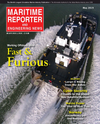
Page 29: of Maritime Reporter Magazine (May 2015)
The Marine Propulsion Edition
Read this page in Pdf, Flash or Html5 edition of May 2015 Maritime Reporter Magazine
jamming unit was positioned 25m above oning and the ability to use piloting in- continues on new GPS receivers that necessity be stronger than GPS satellite- ground level with a maximum power of struments. Routine ship drills should can identify non-GPS signals by their generated signals). In addition to receiv- 1.58 watts. These tests demonstrated include signal loss and spoo? ng of the relative location (jamming and spoo? ng er signal strength alarms and specialized that relatively small jamming units can signal. signals come from the terrestrial loca- antennas, the effects of intentional jam- effect GNSS reception over great dis- tions not satellites) and their strength ming could be mitigated through the use tances (Grant, Williams, Ward, & Bask- • Improved Equipment. Development (jamming and spoo? ng signals must by of inertial navigation systems (INS) and er, 2008).
Threat Scenarios
At this time, the three most likely GPS maritime cyber threat scenarios to con-
Safety is not just one piece sider are: of equipment on a ship – it’s a • Jamming of a port or other con- whole service. At Inmarsat, we’re gested waterway by an individual or not only the sole provider of small group of non-state actors using small, portable jammers. Rapid move-
GMDSS, but we also ofer a range ment of these individuals, coupled with of flexible, customisable safety intermittent use of the jammer(s) would and regulatory services to make make it very dif? cult for local law en- your fleet as safe and secure as forcement of? cials to track and arrest the perpetrators quickly. Attacks of this type possible – paving the way for ship can lead to signi? cant economic losses and crew safety enhancements as well as loss of con? dence by system that are carefully tailored to users. your needs.
• State-sponsored GNSS Jamming.
The most well documented examples of state sponsored jamming attacks oc- curred in the Republic of Korea (see Ta- ble 1). On three different occasions, the
Republic of Korea was subjected to in- tentional, high-power jamming by North
Korea over a wide area. The source of these attacks appear to have been large truck-mounted jamming units placed at strategic geographic locations (Figure 6). Amongst the many attacks, the 2012 attack affected over 1000 aircraft and 250 ships (Seo & Kim, 2013).
• State-sponsored Spoo? ng. Eventu- ally, spoo? ng may pose a signi? cant maritime threat to GNSS as it has the po-
ENHANCED tential to lead vessels astray into danger- ous waters, resulting in signi? cant loss of life (cruise liners and ferries) or envi- ronmental damage. Presently, spoo? ng requires a level of technical sophistica-
SAFETY tion that is normally presented through nation states. However, small groups have conducted successful spoo? ng tests, most notably students at the Uni- versity of Texas under Professor Todd
SERVICES
Humphreys.
Primary Defenses Against Jamming • Improved Maritime Training and
Education. Ship crews should be taught
SAFER, SMARTER SHIPPING how GNSS systems interact with ship systems and how to recognize when
Inmarsat ofers your ship a highly evolved maritime communications ecosystem which makes every trip or voyage more efcient, safer and more productive. In short, just a lot smarter.
GNSS signals may have been compro-
Visit inmarsat.com/safety mised. The maritime industry should also be encouraged to maintain basic seamanship skills, such as dead reck- www.marinelink.com 29
MR #5 (26-33).indd 29 MR #5 (26-33).indd 29 5/1/2015 10:05:51 AM5/1/2015 10:05:51 AM

 28
28

 30
30
